Project Failure Analysis: Human, Organizational, and Change
VerifiedAdded on 2022/09/23
|17
|4515
|31
Report
AI Summary
This report offers a critical review of project management and project success criteria, drawing on extensive literature from the 1970s onwards, with a focus on the lessons learned from project failures, particularly in the IT sector. The analysis delves into the main reasons for project failures, including issues in project leadership, communication, and human resource management. The report examines key factors contributing to project failures, such as people, processes, products, and technology. It also explores best practices for overcoming these challenges, including effective planning, the role of project managers, top management support, accurate specifications, and robust risk management and communication strategies. The report emphasizes the human and organizational aspects of project failures, providing examples and insights to improve future project outcomes.
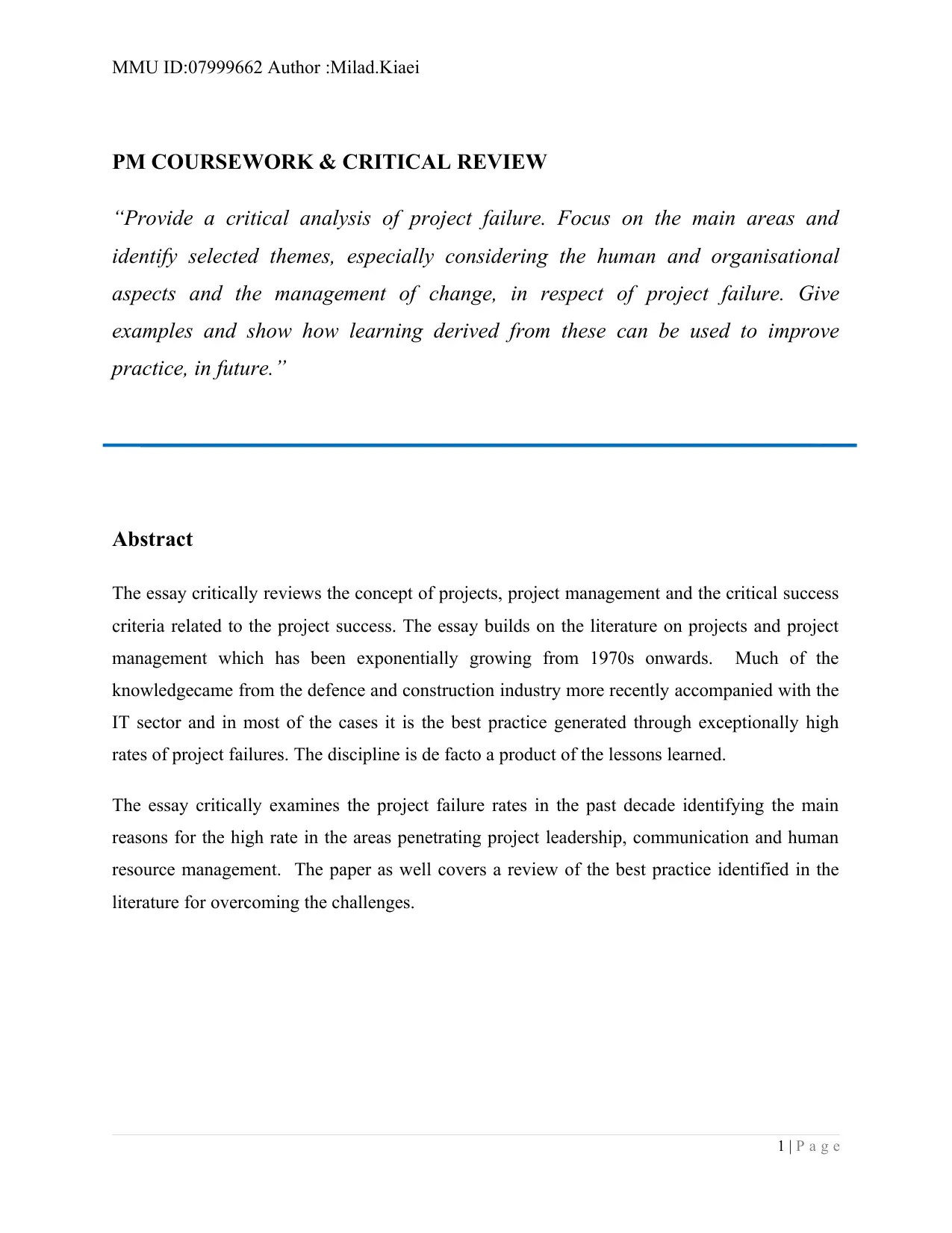
MMU ID:07999662 Author :Milad.Kiaei
PM COURSEWORK & CRITICAL REVIEW
“Provide a critical analysis of project failure. Focus on the main areas and
identify selected themes, especially considering the human and organisational
aspects and the management of change, in respect of project failure. Give
examples and show how learning derived from these can be used to improve
practice, in future.”
Abstract
The essay critically reviews the concept of projects, project management and the critical success
criteria related to the project success. The essay builds on the literature on projects and project
management which has been exponentially growing from 1970s onwards. Much of the
knowledgecame from the defence and construction industry more recently accompanied with the
IT sector and in most of the cases it is the best practice generated through exceptionally high
rates of project failures. The discipline is de facto a product of the lessons learned.
The essay critically examines the project failure rates in the past decade identifying the main
reasons for the high rate in the areas penetrating project leadership, communication and human
resource management. The paper as well covers a review of the best practice identified in the
literature for overcoming the challenges.
1 | P a g e
PM COURSEWORK & CRITICAL REVIEW
“Provide a critical analysis of project failure. Focus on the main areas and
identify selected themes, especially considering the human and organisational
aspects and the management of change, in respect of project failure. Give
examples and show how learning derived from these can be used to improve
practice, in future.”
Abstract
The essay critically reviews the concept of projects, project management and the critical success
criteria related to the project success. The essay builds on the literature on projects and project
management which has been exponentially growing from 1970s onwards. Much of the
knowledgecame from the defence and construction industry more recently accompanied with the
IT sector and in most of the cases it is the best practice generated through exceptionally high
rates of project failures. The discipline is de facto a product of the lessons learned.
The essay critically examines the project failure rates in the past decade identifying the main
reasons for the high rate in the areas penetrating project leadership, communication and human
resource management. The paper as well covers a review of the best practice identified in the
literature for overcoming the challenges.
1 | P a g e
Paraphrase This Document
Need a fresh take? Get an instant paraphrase of this document with our AI Paraphraser
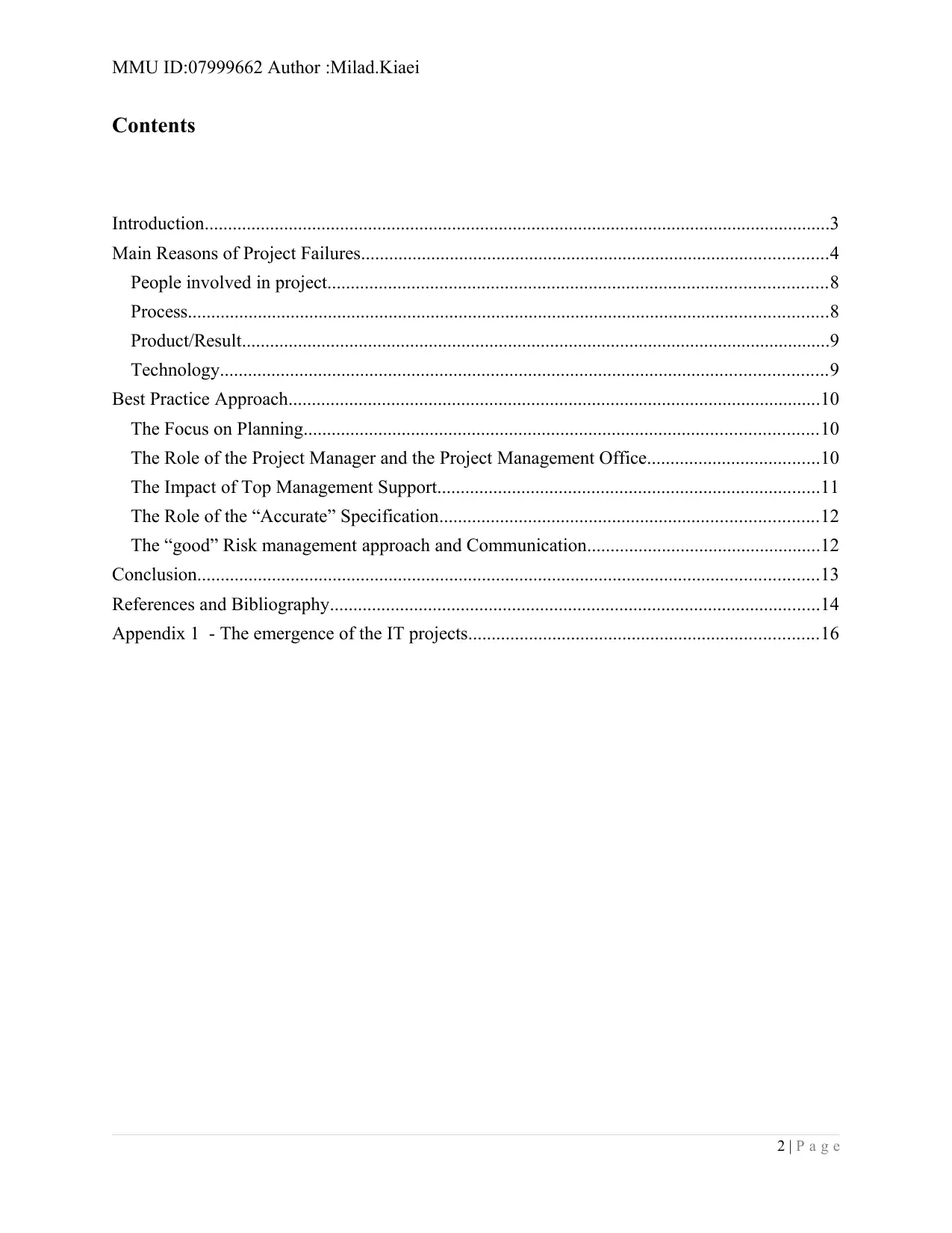
MMU ID:07999662 Author :Milad.Kiaei
Contents
Introduction......................................................................................................................................3
Main Reasons of Project Failures....................................................................................................4
People involved in project...........................................................................................................8
Process.........................................................................................................................................8
Product/Result..............................................................................................................................9
Technology..................................................................................................................................9
Best Practice Approach..................................................................................................................10
The Focus on Planning..............................................................................................................10
The Role of the Project Manager and the Project Management Office.....................................10
The Impact of Top Management Support..................................................................................11
The Role of the “Accurate” Specification.................................................................................12
The “good” Risk management approach and Communication..................................................12
Conclusion.....................................................................................................................................13
References and Bibliography.........................................................................................................14
Appendix 1 - The emergence of the IT projects...........................................................................16
2 | P a g e
Contents
Introduction......................................................................................................................................3
Main Reasons of Project Failures....................................................................................................4
People involved in project...........................................................................................................8
Process.........................................................................................................................................8
Product/Result..............................................................................................................................9
Technology..................................................................................................................................9
Best Practice Approach..................................................................................................................10
The Focus on Planning..............................................................................................................10
The Role of the Project Manager and the Project Management Office.....................................10
The Impact of Top Management Support..................................................................................11
The Role of the “Accurate” Specification.................................................................................12
The “good” Risk management approach and Communication..................................................12
Conclusion.....................................................................................................................................13
References and Bibliography.........................................................................................................14
Appendix 1 - The emergence of the IT projects...........................................................................16
2 | P a g e
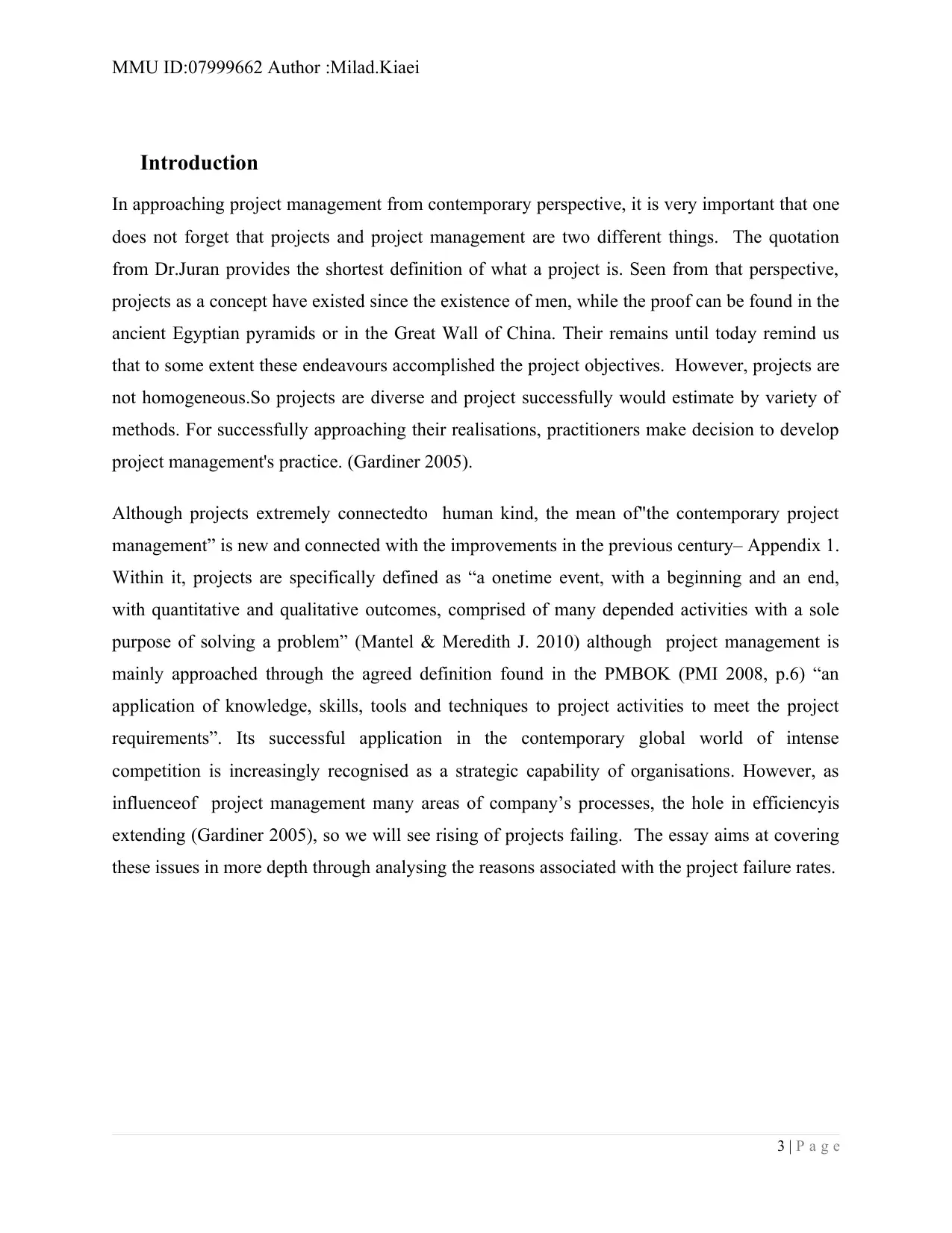
MMU ID:07999662 Author :Milad.Kiaei
Introduction
In approaching project management from contemporary perspective, it is very important that one
does not forget that projects and project management are two different things. The quotation
from Dr.Juran provides the shortest definition of what a project is. Seen from that perspective,
projects as a concept have existed since the existence of men, while the proof can be found in the
ancient Egyptian pyramids or in the Great Wall of China. Their remains until today remind us
that to some extent these endeavours accomplished the project objectives. However, projects are
not homogeneous.So projects are diverse and project successfully would estimate by variety of
methods. For successfully approaching their realisations, practitioners make decision to develop
project management's practice. (Gardiner 2005).
Although projects extremely connectedto human kind, the mean of"the contemporary project
management” is new and connected with the improvements in the previous century– Appendix 1.
Within it, projects are specifically defined as “a onetime event, with a beginning and an end,
with quantitative and qualitative outcomes, comprised of many depended activities with a sole
purpose of solving a problem” (Mantel & Meredith J. 2010) although project management is
mainly approached through the agreed definition found in the PMBOK (PMI 2008, p.6) “an
application of knowledge, skills, tools and techniques to project activities to meet the project
requirements”. Its successful application in the contemporary global world of intense
competition is increasingly recognised as a strategic capability of organisations. However, as
influenceof project management many areas of company’s processes, the hole in efficiencyis
extending (Gardiner 2005), so we will see rising of projects failing. The essay aims at covering
these issues in more depth through analysing the reasons associated with the project failure rates.
3 | P a g e
Introduction
In approaching project management from contemporary perspective, it is very important that one
does not forget that projects and project management are two different things. The quotation
from Dr.Juran provides the shortest definition of what a project is. Seen from that perspective,
projects as a concept have existed since the existence of men, while the proof can be found in the
ancient Egyptian pyramids or in the Great Wall of China. Their remains until today remind us
that to some extent these endeavours accomplished the project objectives. However, projects are
not homogeneous.So projects are diverse and project successfully would estimate by variety of
methods. For successfully approaching their realisations, practitioners make decision to develop
project management's practice. (Gardiner 2005).
Although projects extremely connectedto human kind, the mean of"the contemporary project
management” is new and connected with the improvements in the previous century– Appendix 1.
Within it, projects are specifically defined as “a onetime event, with a beginning and an end,
with quantitative and qualitative outcomes, comprised of many depended activities with a sole
purpose of solving a problem” (Mantel & Meredith J. 2010) although project management is
mainly approached through the agreed definition found in the PMBOK (PMI 2008, p.6) “an
application of knowledge, skills, tools and techniques to project activities to meet the project
requirements”. Its successful application in the contemporary global world of intense
competition is increasingly recognised as a strategic capability of organisations. However, as
influenceof project management many areas of company’s processes, the hole in efficiencyis
extending (Gardiner 2005), so we will see rising of projects failing. The essay aims at covering
these issues in more depth through analysing the reasons associated with the project failure rates.
3 | P a g e
⊘ This is a preview!⊘
Do you want full access?
Subscribe today to unlock all pages.

Trusted by 1+ million students worldwide
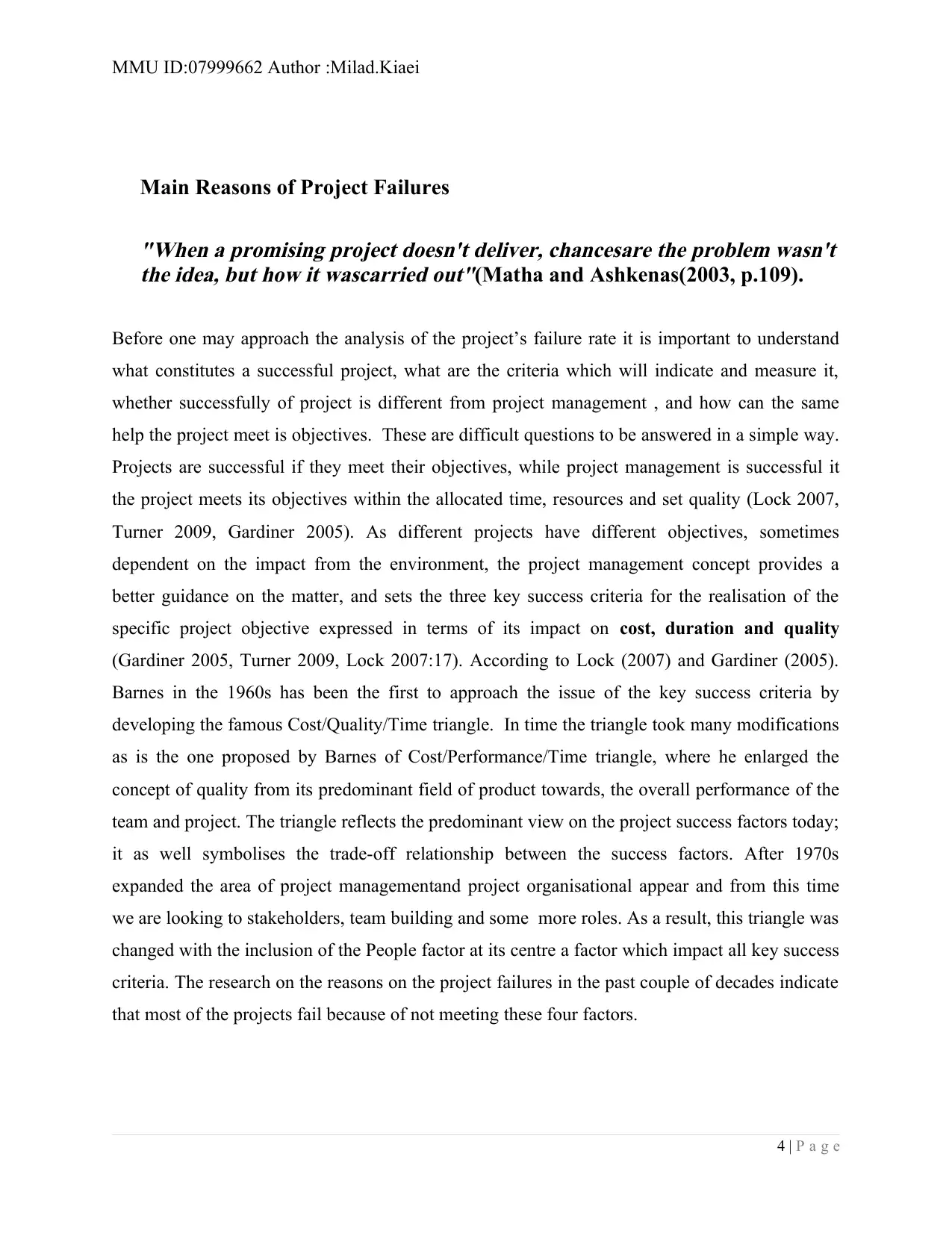
MMU ID:07999662 Author :Milad.Kiaei
Main Reasons of Project Failures
"When a promising project doesn't deliver, chancesare the problem wasn't
the idea, but how it wascarried out"(Matha and Ashkenas(2003, p.109).
Before one may approach the analysis of the project’s failure rate it is important to understand
what constitutes a successful project, what are the criteria which will indicate and measure it,
whether successfully of project is different from project management , and how can the same
help the project meet is objectives. These are difficult questions to be answered in a simple way.
Projects are successful if they meet their objectives, while project management is successful it
the project meets its objectives within the allocated time, resources and set quality (Lock 2007,
Turner 2009, Gardiner 2005). As different projects have different objectives, sometimes
dependent on the impact from the environment, the project management concept provides a
better guidance on the matter, and sets the three key success criteria for the realisation of the
specific project objective expressed in terms of its impact on cost, duration and quality
(Gardiner 2005, Turner 2009, Lock 2007:17). According to Lock (2007) and Gardiner (2005).
Barnes in the 1960s has been the first to approach the issue of the key success criteria by
developing the famous Cost/Quality/Time triangle. In time the triangle took many modifications
as is the one proposed by Barnes of Cost/Performance/Time triangle, where he enlarged the
concept of quality from its predominant field of product towards, the overall performance of the
team and project. The triangle reflects the predominant view on the project success factors today;
it as well symbolises the trade-off relationship between the success factors. After 1970s
expanded the area of project managementand project organisational appear and from this time
we are looking to stakeholders, team building and some more roles. As a result, this triangle was
changed with the inclusion of the People factor at its centre a factor which impact all key success
criteria. The research on the reasons on the project failures in the past couple of decades indicate
that most of the projects fail because of not meeting these four factors.
4 | P a g e
Main Reasons of Project Failures
"When a promising project doesn't deliver, chancesare the problem wasn't
the idea, but how it wascarried out"(Matha and Ashkenas(2003, p.109).
Before one may approach the analysis of the project’s failure rate it is important to understand
what constitutes a successful project, what are the criteria which will indicate and measure it,
whether successfully of project is different from project management , and how can the same
help the project meet is objectives. These are difficult questions to be answered in a simple way.
Projects are successful if they meet their objectives, while project management is successful it
the project meets its objectives within the allocated time, resources and set quality (Lock 2007,
Turner 2009, Gardiner 2005). As different projects have different objectives, sometimes
dependent on the impact from the environment, the project management concept provides a
better guidance on the matter, and sets the three key success criteria for the realisation of the
specific project objective expressed in terms of its impact on cost, duration and quality
(Gardiner 2005, Turner 2009, Lock 2007:17). According to Lock (2007) and Gardiner (2005).
Barnes in the 1960s has been the first to approach the issue of the key success criteria by
developing the famous Cost/Quality/Time triangle. In time the triangle took many modifications
as is the one proposed by Barnes of Cost/Performance/Time triangle, where he enlarged the
concept of quality from its predominant field of product towards, the overall performance of the
team and project. The triangle reflects the predominant view on the project success factors today;
it as well symbolises the trade-off relationship between the success factors. After 1970s
expanded the area of project managementand project organisational appear and from this time
we are looking to stakeholders, team building and some more roles. As a result, this triangle was
changed with the inclusion of the People factor at its centre a factor which impact all key success
criteria. The research on the reasons on the project failures in the past couple of decades indicate
that most of the projects fail because of not meeting these four factors.
4 | P a g e
Paraphrase This Document
Need a fresh take? Get an instant paraphrase of this document with our AI Paraphraser
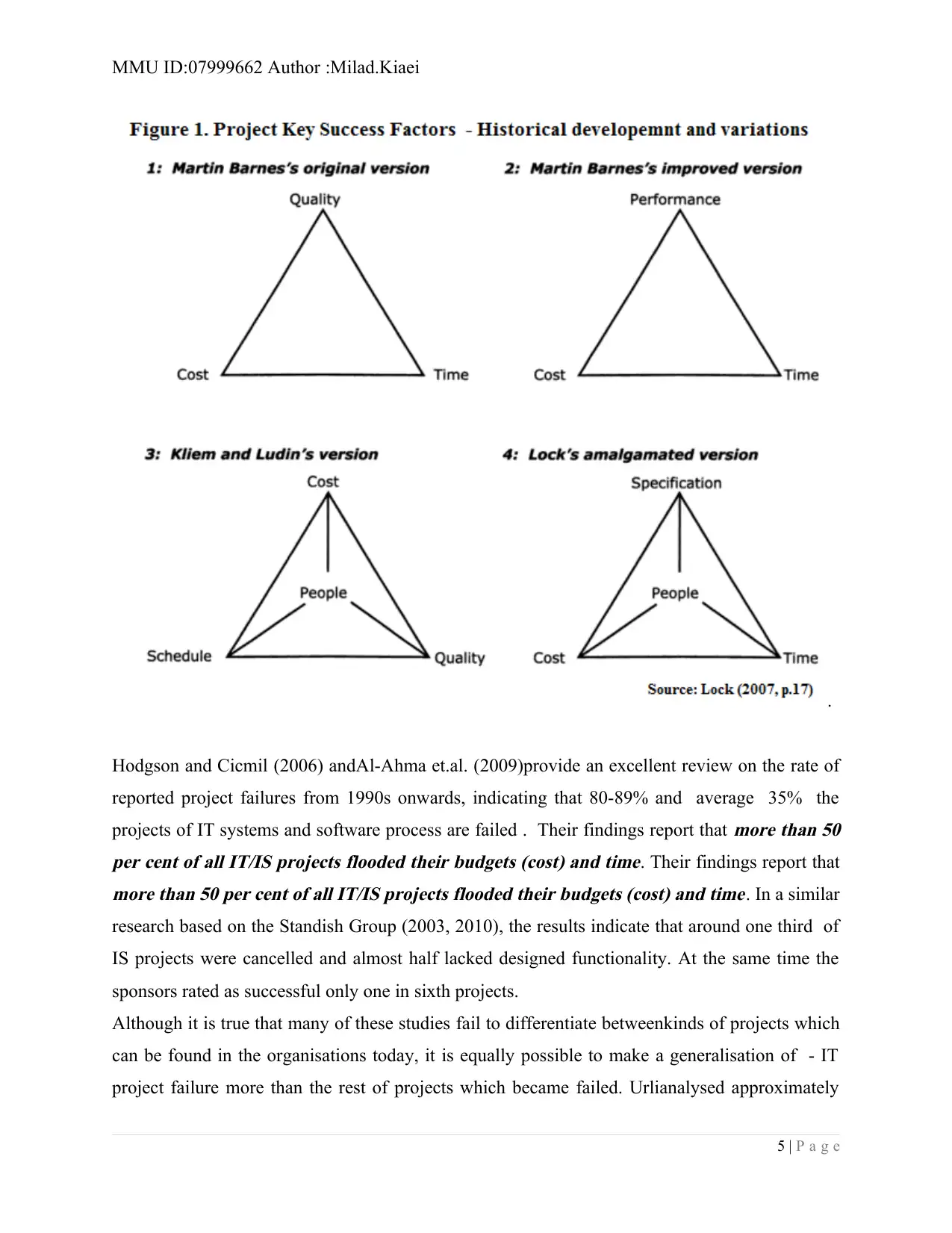
MMU ID:07999662 Author :Milad.Kiaei
.
Hodgson and Cicmil (2006) andAl-Ahma et.al. (2009)provide an excellent review on the rate of
reported project failures from 1990s onwards, indicating that 80-89% and average 35% the
projects of IT systems and software process are failed . Their findings report that
more than 50
per cent of all IT/IS projects flooded their budgets (cost) and time. Their findings report thatmore than 50 per cent of all IT/IS projects flooded their budgets (cost) and time. In a similar
research based on the Standish Group (2003, 2010), the results indicate that around one third of
IS projects were cancelled and almost half lacked designed functionality. At the same time the
sponsors rated as successful only one in sixth projects.
Although it is true that many of these studies fail to differentiate betweenkinds of projects which
can be found in the organisations today, it is equally possible to make a generalisation of - IT
project failure more than the rest of projects which became failed. Urlianalysed approximately
5 | P a g e
.
Hodgson and Cicmil (2006) andAl-Ahma et.al. (2009)provide an excellent review on the rate of
reported project failures from 1990s onwards, indicating that 80-89% and average 35% the
projects of IT systems and software process are failed . Their findings report that
more than 50
per cent of all IT/IS projects flooded their budgets (cost) and time. Their findings report thatmore than 50 per cent of all IT/IS projects flooded their budgets (cost) and time. In a similar
research based on the Standish Group (2003, 2010), the results indicate that around one third of
IS projects were cancelled and almost half lacked designed functionality. At the same time the
sponsors rated as successful only one in sixth projects.
Although it is true that many of these studies fail to differentiate betweenkinds of projects which
can be found in the organisations today, it is equally possible to make a generalisation of - IT
project failure more than the rest of projects which became failed. Urlianalysed approximately
5 | P a g e
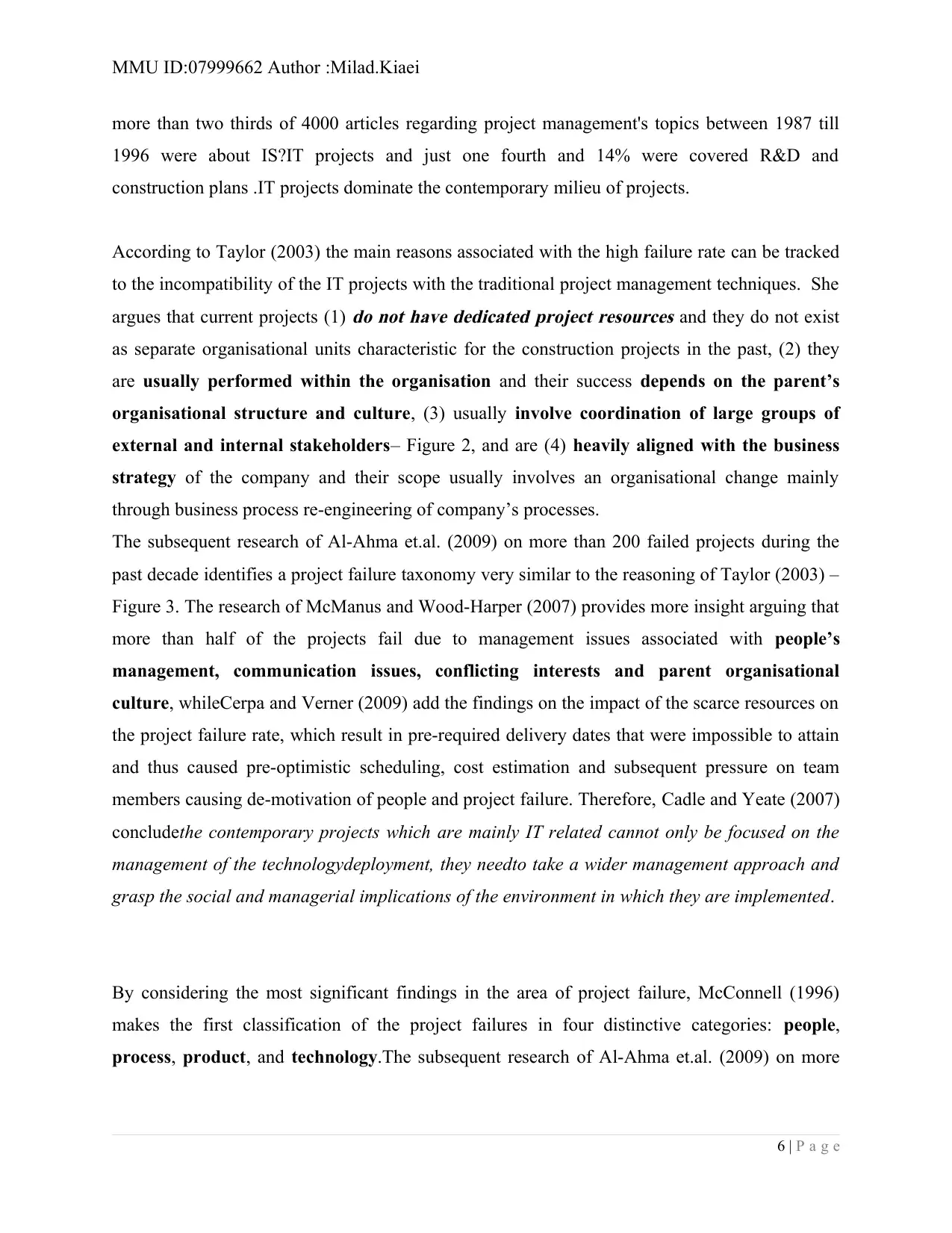
MMU ID:07999662 Author :Milad.Kiaei
more than two thirds of 4000 articles regarding project management's topics between 1987 till
1996 were about IS?IT projects and just one fourth and 14% were covered R&D and
construction plans .IT projects dominate the contemporary milieu of projects.
According to Taylor (2003) the main reasons associated with the high failure rate can be tracked
to the incompatibility of the IT projects with the traditional project management techniques. She
argues that current projects (1)
do not have dedicated project resources and they do not exist
as separate organisational units characteristic for the construction projects in the past, (2) they
are usually performed within the organisation and their success depends on the parent’s
organisational structure and culture, (3) usually involve coordination of large groups of
external and internal stakeholders– Figure 2, and are (4) heavily aligned with the business
strategy of the company and their scope usually involves an organisational change mainly
through business process re-engineering of company’s processes.
The subsequent research of Al-Ahma et.al. (2009) on more than 200 failed projects during the
past decade identifies a project failure taxonomy very similar to the reasoning of Taylor (2003) –
Figure 3. The research of McManus and Wood-Harper (2007) provides more insight arguing that
more than half of the projects fail due to management issues associated with people’s
management, communication issues, conflicting interests and parent organisational
culture, whileCerpa and Verner (2009) add the findings on the impact of the scarce resources on
the project failure rate, which result in pre-required delivery dates that were impossible to attain
and thus caused pre-optimistic scheduling, cost estimation and subsequent pressure on team
members causing de-motivation of people and project failure. Therefore, Cadle and Yeate (2007)
concludethe contemporary projects which are mainly IT related cannot only be focused on the
management of the technologydeployment, they needto take a wider management approach and
grasp the social and managerial implications of the environment in which they are implemented.
By considering the most significant findings in the area of project failure, McConnell (1996)
makes the first classification of the project failures in four distinctive categories: people,
process, product, and technology.The subsequent research of Al-Ahma et.al. (2009) on more
6 | P a g e
more than two thirds of 4000 articles regarding project management's topics between 1987 till
1996 were about IS?IT projects and just one fourth and 14% were covered R&D and
construction plans .IT projects dominate the contemporary milieu of projects.
According to Taylor (2003) the main reasons associated with the high failure rate can be tracked
to the incompatibility of the IT projects with the traditional project management techniques. She
argues that current projects (1)
do not have dedicated project resources and they do not exist
as separate organisational units characteristic for the construction projects in the past, (2) they
are usually performed within the organisation and their success depends on the parent’s
organisational structure and culture, (3) usually involve coordination of large groups of
external and internal stakeholders– Figure 2, and are (4) heavily aligned with the business
strategy of the company and their scope usually involves an organisational change mainly
through business process re-engineering of company’s processes.
The subsequent research of Al-Ahma et.al. (2009) on more than 200 failed projects during the
past decade identifies a project failure taxonomy very similar to the reasoning of Taylor (2003) –
Figure 3. The research of McManus and Wood-Harper (2007) provides more insight arguing that
more than half of the projects fail due to management issues associated with people’s
management, communication issues, conflicting interests and parent organisational
culture, whileCerpa and Verner (2009) add the findings on the impact of the scarce resources on
the project failure rate, which result in pre-required delivery dates that were impossible to attain
and thus caused pre-optimistic scheduling, cost estimation and subsequent pressure on team
members causing de-motivation of people and project failure. Therefore, Cadle and Yeate (2007)
concludethe contemporary projects which are mainly IT related cannot only be focused on the
management of the technologydeployment, they needto take a wider management approach and
grasp the social and managerial implications of the environment in which they are implemented.
By considering the most significant findings in the area of project failure, McConnell (1996)
makes the first classification of the project failures in four distinctive categories: people,
process, product, and technology.The subsequent research of Al-Ahma et.al. (2009) on more
6 | P a g e
⊘ This is a preview!⊘
Do you want full access?
Subscribe today to unlock all pages.

Trusted by 1+ million students worldwide
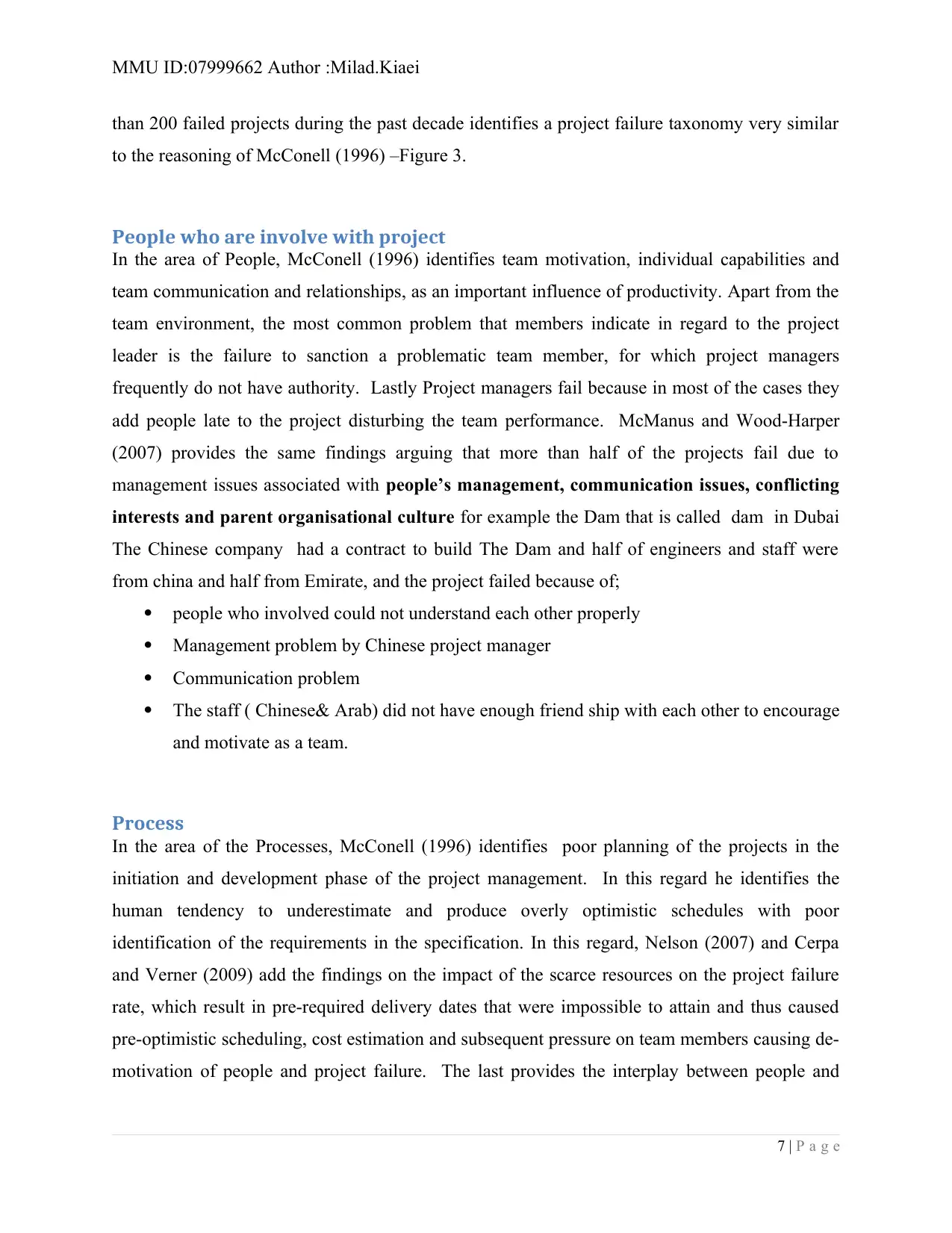
MMU ID:07999662 Author :Milad.Kiaei
than 200 failed projects during the past decade identifies a project failure taxonomy very similar
to the reasoning of McConell (1996) –Figure 3.
People who are involve with project
In the area of People, McConell (1996) identifies team motivation, individual capabilities and
team communication and relationships, as an important influence of productivity. Apart from the
team environment, the most common problem that members indicate in regard to the project
leader is the failure to sanction a problematic team member, for which project managers
frequently do not have authority. Lastly Project managers fail because in most of the cases they
add people late to the project disturbing the team performance. McManus and Wood-Harper
(2007) provides the same findings arguing that more than half of the projects fail due to
management issues associated with people’s management, communication issues, conflicting
interests and parent organisational culture for example the Dam that is called dam in Dubai
The Chinese company had a contract to build The Dam and half of engineers and staff were
from china and half from Emirate, and the project failed because of;
people who involved could not understand each other properly
Management problem by Chinese project manager
Communication problem
The staff ( Chinese& Arab) did not have enough friend ship with each other to encourage
and motivate as a team.
Process
In the area of the Processes, McConell (1996) identifies poor planning of the projects in the
initiation and development phase of the project management. In this regard he identifies the
human tendency to underestimate and produce overly optimistic schedules with poor
identification of the requirements in the specification. In this regard, Nelson (2007) and Cerpa
and Verner (2009) add the findings on the impact of the scarce resources on the project failure
rate, which result in pre-required delivery dates that were impossible to attain and thus caused
pre-optimistic scheduling, cost estimation and subsequent pressure on team members causing de-
motivation of people and project failure. The last provides the interplay between people and
7 | P a g e
than 200 failed projects during the past decade identifies a project failure taxonomy very similar
to the reasoning of McConell (1996) –Figure 3.
People who are involve with project
In the area of People, McConell (1996) identifies team motivation, individual capabilities and
team communication and relationships, as an important influence of productivity. Apart from the
team environment, the most common problem that members indicate in regard to the project
leader is the failure to sanction a problematic team member, for which project managers
frequently do not have authority. Lastly Project managers fail because in most of the cases they
add people late to the project disturbing the team performance. McManus and Wood-Harper
(2007) provides the same findings arguing that more than half of the projects fail due to
management issues associated with people’s management, communication issues, conflicting
interests and parent organisational culture for example the Dam that is called dam in Dubai
The Chinese company had a contract to build The Dam and half of engineers and staff were
from china and half from Emirate, and the project failed because of;
people who involved could not understand each other properly
Management problem by Chinese project manager
Communication problem
The staff ( Chinese& Arab) did not have enough friend ship with each other to encourage
and motivate as a team.
Process
In the area of the Processes, McConell (1996) identifies poor planning of the projects in the
initiation and development phase of the project management. In this regard he identifies the
human tendency to underestimate and produce overly optimistic schedules with poor
identification of the requirements in the specification. In this regard, Nelson (2007) and Cerpa
and Verner (2009) add the findings on the impact of the scarce resources on the project failure
rate, which result in pre-required delivery dates that were impossible to attain and thus caused
pre-optimistic scheduling, cost estimation and subsequent pressure on team members causing de-
motivation of people and project failure. The last provides the interplay between people and
7 | P a g e
Paraphrase This Document
Need a fresh take? Get an instant paraphrase of this document with our AI Paraphraser
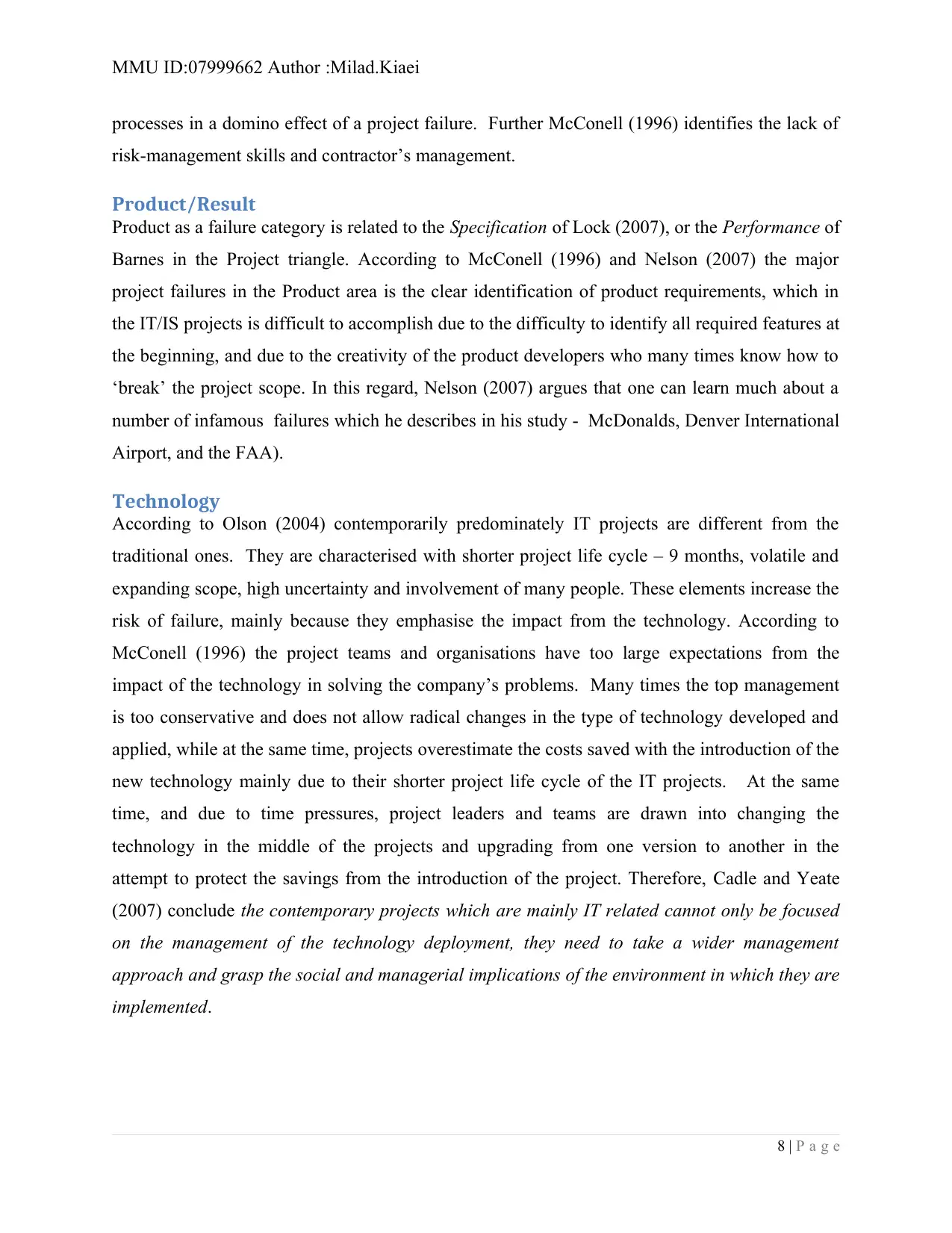
MMU ID:07999662 Author :Milad.Kiaei
processes in a domino effect of a project failure. Further McConell (1996) identifies the lack of
risk-management skills and contractor’s management.
Product/Result
Product as a failure category is related to the Specification of Lock (2007), or the Performance of
Barnes in the Project triangle. According to McConell (1996) and Nelson (2007) the major
project failures in the Product area is the clear identification of product requirements, which in
the IT/IS projects is difficult to accomplish due to the difficulty to identify all required features at
the beginning, and due to the creativity of the product developers who many times know how to
‘break’ the project scope. In this regard, Nelson (2007) argues that one can learn much about a
number of infamous failures which he describes in his study - McDonalds, Denver International
Airport, and the FAA).
Technology
According to Olson (2004) contemporarily predominately IT projects are different from the
traditional ones. They are characterised with shorter project life cycle – 9 months, volatile and
expanding scope, high uncertainty and involvement of many people. These elements increase the
risk of failure, mainly because they emphasise the impact from the technology. According to
McConell (1996) the project teams and organisations have too large expectations from the
impact of the technology in solving the company’s problems. Many times the top management
is too conservative and does not allow radical changes in the type of technology developed and
applied, while at the same time, projects overestimate the costs saved with the introduction of the
new technology mainly due to their shorter project life cycle of the IT projects. At the same
time, and due to time pressures, project leaders and teams are drawn into changing the
technology in the middle of the projects and upgrading from one version to another in the
attempt to protect the savings from the introduction of the project. Therefore, Cadle and Yeate
(2007) conclude the contemporary projects which are mainly IT related cannot only be focused
on the management of the technology deployment, they need to take a wider management
approach and grasp the social and managerial implications of the environment in which they are
implemented.
8 | P a g e
processes in a domino effect of a project failure. Further McConell (1996) identifies the lack of
risk-management skills and contractor’s management.
Product/Result
Product as a failure category is related to the Specification of Lock (2007), or the Performance of
Barnes in the Project triangle. According to McConell (1996) and Nelson (2007) the major
project failures in the Product area is the clear identification of product requirements, which in
the IT/IS projects is difficult to accomplish due to the difficulty to identify all required features at
the beginning, and due to the creativity of the product developers who many times know how to
‘break’ the project scope. In this regard, Nelson (2007) argues that one can learn much about a
number of infamous failures which he describes in his study - McDonalds, Denver International
Airport, and the FAA).
Technology
According to Olson (2004) contemporarily predominately IT projects are different from the
traditional ones. They are characterised with shorter project life cycle – 9 months, volatile and
expanding scope, high uncertainty and involvement of many people. These elements increase the
risk of failure, mainly because they emphasise the impact from the technology. According to
McConell (1996) the project teams and organisations have too large expectations from the
impact of the technology in solving the company’s problems. Many times the top management
is too conservative and does not allow radical changes in the type of technology developed and
applied, while at the same time, projects overestimate the costs saved with the introduction of the
new technology mainly due to their shorter project life cycle of the IT projects. At the same
time, and due to time pressures, project leaders and teams are drawn into changing the
technology in the middle of the projects and upgrading from one version to another in the
attempt to protect the savings from the introduction of the project. Therefore, Cadle and Yeate
(2007) conclude the contemporary projects which are mainly IT related cannot only be focused
on the management of the technology deployment, they need to take a wider management
approach and grasp the social and managerial implications of the environment in which they are
implemented.
8 | P a g e
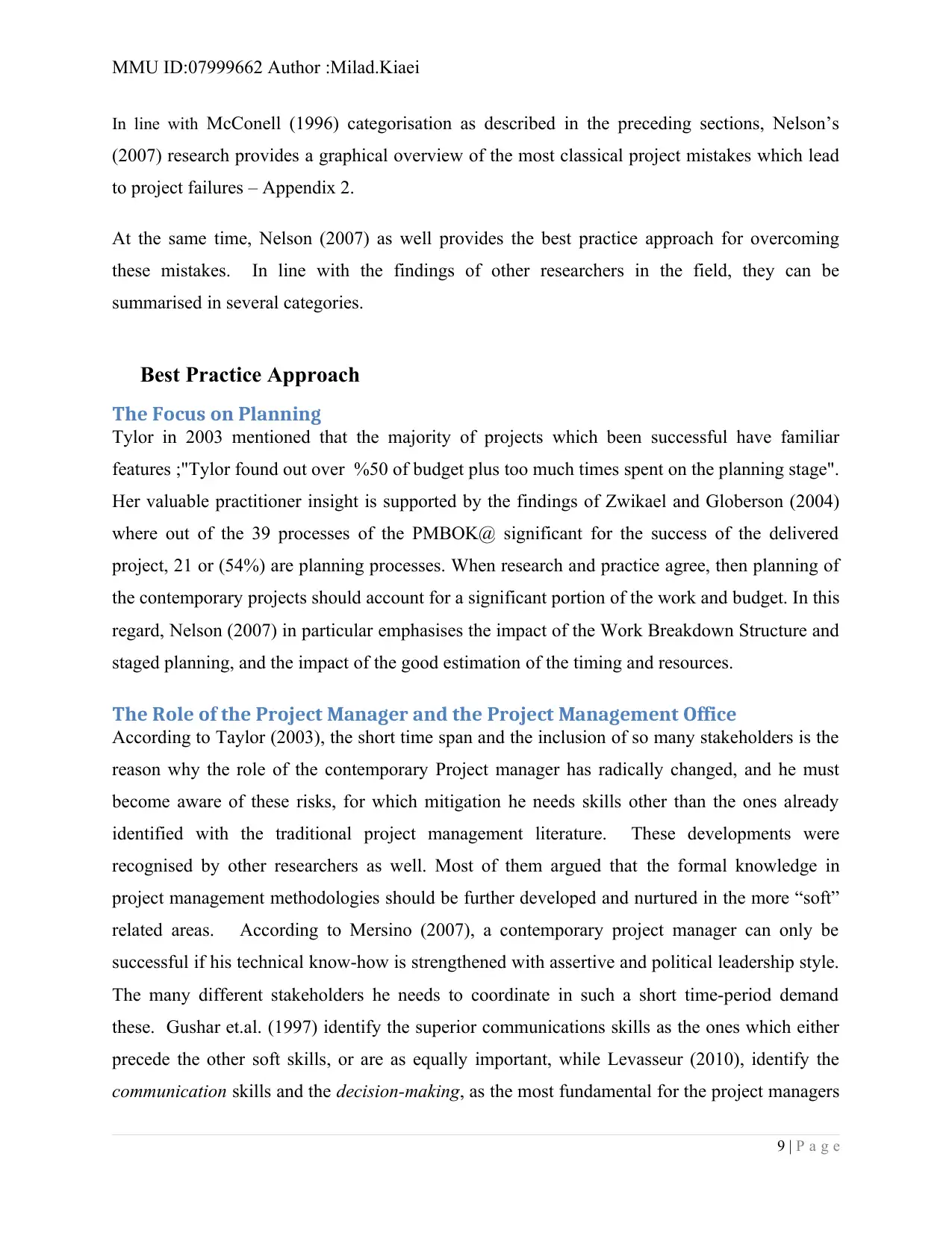
MMU ID:07999662 Author :Milad.Kiaei
In line with McConell (1996) categorisation as described in the preceding sections, Nelson’s
(2007) research provides a graphical overview of the most classical project mistakes which lead
to project failures – Appendix 2.
At the same time, Nelson (2007) as well provides the best practice approach for overcoming
these mistakes. In line with the findings of other researchers in the field, they can be
summarised in several categories.
Best Practice Approach
The Focus on Planning
Tylor in 2003 mentioned that the majority of projects which been successful have familiar
features ;"Tylor found out over %50 of budget plus too much times spent on the planning stage".
Her valuable practitioner insight is supported by the findings of Zwikael and Globerson (2004)
where out of the 39 processes of the PMBOK@ significant for the success of the delivered
project, 21 or (54%) are planning processes. When research and practice agree, then planning of
the contemporary projects should account for a significant portion of the work and budget. In this
regard, Nelson (2007) in particular emphasises the impact of the Work Breakdown Structure and
staged planning, and the impact of the good estimation of the timing and resources.
The Role of the Project Manager and the Project Management Office
According to Taylor (2003), the short time span and the inclusion of so many stakeholders is the
reason why the role of the contemporary Project manager has radically changed, and he must
become aware of these risks, for which mitigation he needs skills other than the ones already
identified with the traditional project management literature. These developments were
recognised by other researchers as well. Most of them argued that the formal knowledge in
project management methodologies should be further developed and nurtured in the more “soft”
related areas. According to Mersino (2007), a contemporary project manager can only be
successful if his technical know-how is strengthened with assertive and political leadership style.
The many different stakeholders he needs to coordinate in such a short time-period demand
these. Gushar et.al. (1997) identify the superior communications skills as the ones which either
precede the other soft skills, or are as equally important, while Levasseur (2010), identify the
communication skills and the decision-making, as the most fundamental for the project managers
9 | P a g e
In line with McConell (1996) categorisation as described in the preceding sections, Nelson’s
(2007) research provides a graphical overview of the most classical project mistakes which lead
to project failures – Appendix 2.
At the same time, Nelson (2007) as well provides the best practice approach for overcoming
these mistakes. In line with the findings of other researchers in the field, they can be
summarised in several categories.
Best Practice Approach
The Focus on Planning
Tylor in 2003 mentioned that the majority of projects which been successful have familiar
features ;"Tylor found out over %50 of budget plus too much times spent on the planning stage".
Her valuable practitioner insight is supported by the findings of Zwikael and Globerson (2004)
where out of the 39 processes of the PMBOK@ significant for the success of the delivered
project, 21 or (54%) are planning processes. When research and practice agree, then planning of
the contemporary projects should account for a significant portion of the work and budget. In this
regard, Nelson (2007) in particular emphasises the impact of the Work Breakdown Structure and
staged planning, and the impact of the good estimation of the timing and resources.
The Role of the Project Manager and the Project Management Office
According to Taylor (2003), the short time span and the inclusion of so many stakeholders is the
reason why the role of the contemporary Project manager has radically changed, and he must
become aware of these risks, for which mitigation he needs skills other than the ones already
identified with the traditional project management literature. These developments were
recognised by other researchers as well. Most of them argued that the formal knowledge in
project management methodologies should be further developed and nurtured in the more “soft”
related areas. According to Mersino (2007), a contemporary project manager can only be
successful if his technical know-how is strengthened with assertive and political leadership style.
The many different stakeholders he needs to coordinate in such a short time-period demand
these. Gushar et.al. (1997) identify the superior communications skills as the ones which either
precede the other soft skills, or are as equally important, while Levasseur (2010), identify the
communication skills and the decision-making, as the most fundamental for the project managers
9 | P a g e
⊘ This is a preview!⊘
Do you want full access?
Subscribe today to unlock all pages.

Trusted by 1+ million students worldwide
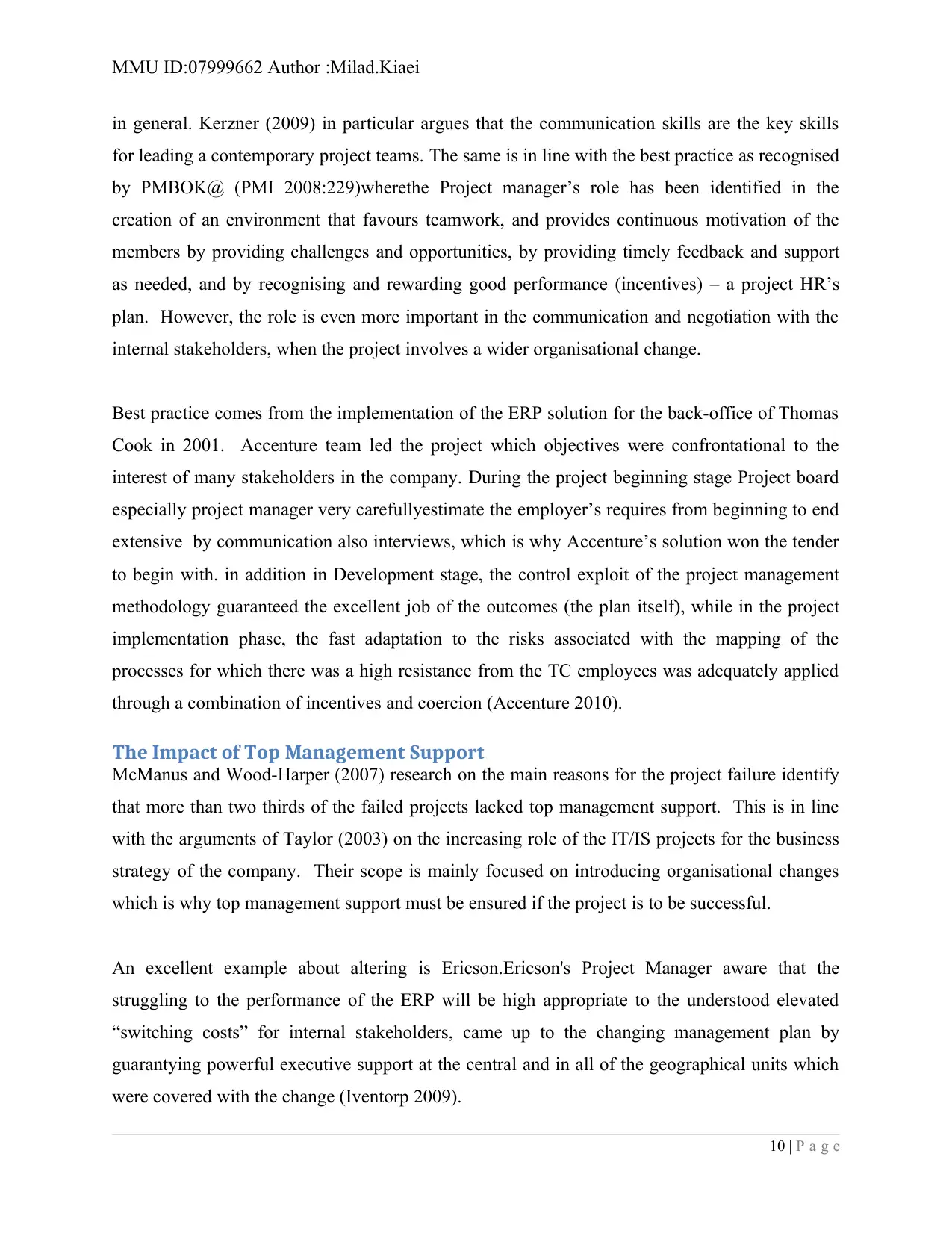
MMU ID:07999662 Author :Milad.Kiaei
in general. Kerzner (2009) in particular argues that the communication skills are the key skills
for leading a contemporary project teams. The same is in line with the best practice as recognised
by PMBOK@ (PMI 2008:229)wherethe Project manager’s role has been identified in the
creation of an environment that favours teamwork, and provides continuous motivation of the
members by providing challenges and opportunities, by providing timely feedback and support
as needed, and by recognising and rewarding good performance (incentives) – a project HR’s
plan. However, the role is even more important in the communication and negotiation with the
internal stakeholders, when the project involves a wider organisational change.
Best practice comes from the implementation of the ERP solution for the back-office of Thomas
Cook in 2001. Accenture team led the project which objectives were confrontational to the
interest of many stakeholders in the company. During the project beginning stage Project board
especially project manager very carefullyestimate the employer’s requires from beginning to end
extensive by communication also interviews, which is why Accenture’s solution won the tender
to begin with. in addition in Development stage, the control exploit of the project management
methodology guaranteed the excellent job of the outcomes (the plan itself), while in the project
implementation phase, the fast adaptation to the risks associated with the mapping of the
processes for which there was a high resistance from the TC employees was adequately applied
through a combination of incentives and coercion (Accenture 2010).
The Impact of Top Management Support
McManus and Wood-Harper (2007) research on the main reasons for the project failure identify
that more than two thirds of the failed projects lacked top management support. This is in line
with the arguments of Taylor (2003) on the increasing role of the IT/IS projects for the business
strategy of the company. Their scope is mainly focused on introducing organisational changes
which is why top management support must be ensured if the project is to be successful.
An excellent example about altering is Ericson.Ericson's Project Manager aware that the
struggling to the performance of the ERP will be high appropriate to the understood elevated
“switching costs” for internal stakeholders, came up to the changing management plan by
guarantying powerful executive support at the central and in all of the geographical units which
were covered with the change (Iventorp 2009).
10 | P a g e
in general. Kerzner (2009) in particular argues that the communication skills are the key skills
for leading a contemporary project teams. The same is in line with the best practice as recognised
by PMBOK@ (PMI 2008:229)wherethe Project manager’s role has been identified in the
creation of an environment that favours teamwork, and provides continuous motivation of the
members by providing challenges and opportunities, by providing timely feedback and support
as needed, and by recognising and rewarding good performance (incentives) – a project HR’s
plan. However, the role is even more important in the communication and negotiation with the
internal stakeholders, when the project involves a wider organisational change.
Best practice comes from the implementation of the ERP solution for the back-office of Thomas
Cook in 2001. Accenture team led the project which objectives were confrontational to the
interest of many stakeholders in the company. During the project beginning stage Project board
especially project manager very carefullyestimate the employer’s requires from beginning to end
extensive by communication also interviews, which is why Accenture’s solution won the tender
to begin with. in addition in Development stage, the control exploit of the project management
methodology guaranteed the excellent job of the outcomes (the plan itself), while in the project
implementation phase, the fast adaptation to the risks associated with the mapping of the
processes for which there was a high resistance from the TC employees was adequately applied
through a combination of incentives and coercion (Accenture 2010).
The Impact of Top Management Support
McManus and Wood-Harper (2007) research on the main reasons for the project failure identify
that more than two thirds of the failed projects lacked top management support. This is in line
with the arguments of Taylor (2003) on the increasing role of the IT/IS projects for the business
strategy of the company. Their scope is mainly focused on introducing organisational changes
which is why top management support must be ensured if the project is to be successful.
An excellent example about altering is Ericson.Ericson's Project Manager aware that the
struggling to the performance of the ERP will be high appropriate to the understood elevated
“switching costs” for internal stakeholders, came up to the changing management plan by
guarantying powerful executive support at the central and in all of the geographical units which
were covered with the change (Iventorp 2009).
10 | P a g e
Paraphrase This Document
Need a fresh take? Get an instant paraphrase of this document with our AI Paraphraser
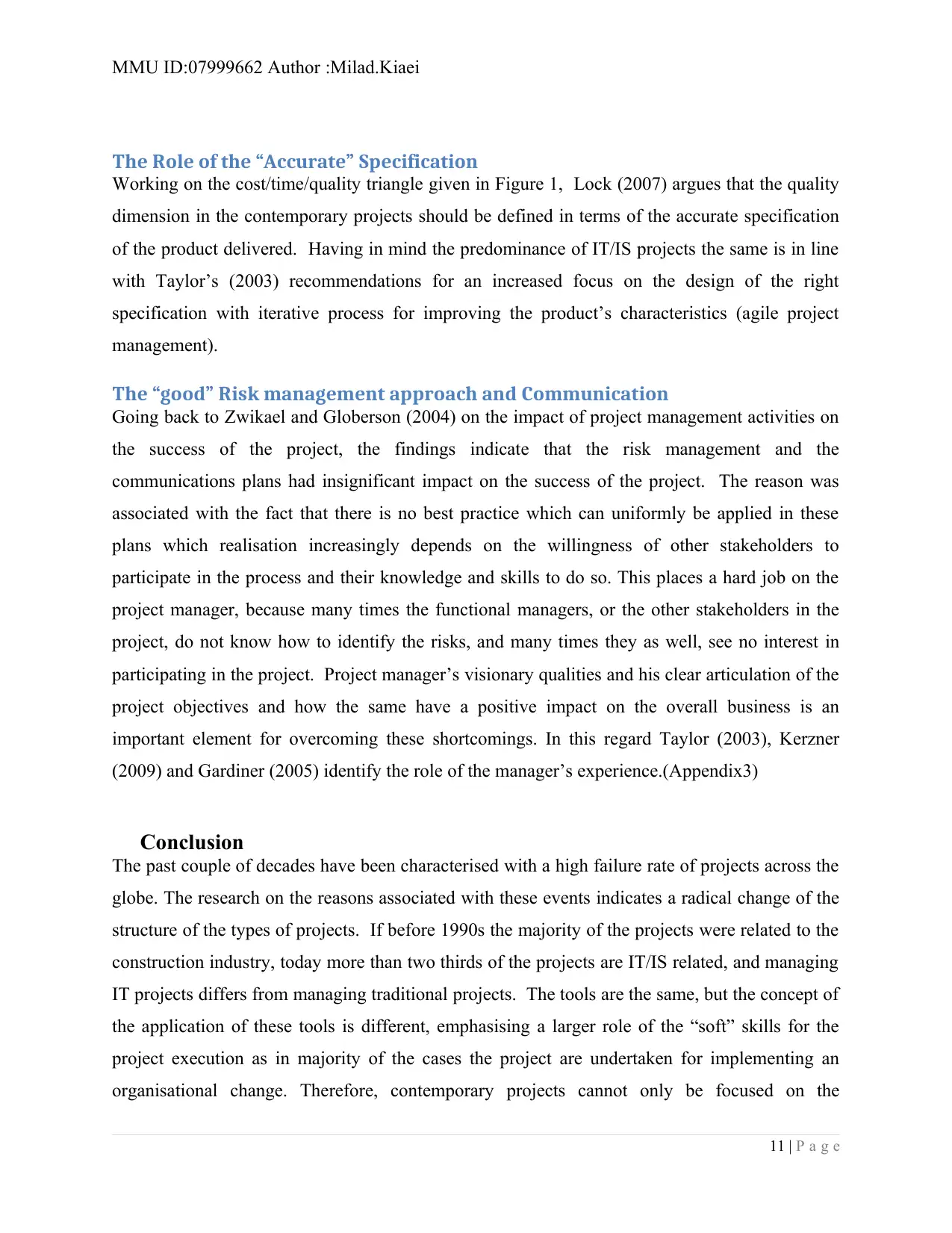
MMU ID:07999662 Author :Milad.Kiaei
The Role of the “Accurate” Specification
Working on the cost/time/quality triangle given in Figure 1, Lock (2007) argues that the quality
dimension in the contemporary projects should be defined in terms of the accurate specification
of the product delivered. Having in mind the predominance of IT/IS projects the same is in line
with Taylor’s (2003) recommendations for an increased focus on the design of the right
specification with iterative process for improving the product’s characteristics (agile project
management).
The “good” Risk management approach and Communication
Going back to Zwikael and Globerson (2004) on the impact of project management activities on
the success of the project, the findings indicate that the risk management and the
communications plans had insignificant impact on the success of the project. The reason was
associated with the fact that there is no best practice which can uniformly be applied in these
plans which realisation increasingly depends on the willingness of other stakeholders to
participate in the process and their knowledge and skills to do so. This places a hard job on the
project manager, because many times the functional managers, or the other stakeholders in the
project, do not know how to identify the risks, and many times they as well, see no interest in
participating in the project. Project manager’s visionary qualities and his clear articulation of the
project objectives and how the same have a positive impact on the overall business is an
important element for overcoming these shortcomings. In this regard Taylor (2003), Kerzner
(2009) and Gardiner (2005) identify the role of the manager’s experience.(Appendix3)
Conclusion
The past couple of decades have been characterised with a high failure rate of projects across the
globe. The research on the reasons associated with these events indicates a radical change of the
structure of the types of projects. If before 1990s the majority of the projects were related to the
construction industry, today more than two thirds of the projects are IT/IS related, and managing
IT projects differs from managing traditional projects. The tools are the same, but the concept of
the application of these tools is different, emphasising a larger role of the “soft” skills for the
project execution as in majority of the cases the project are undertaken for implementing an
organisational change. Therefore, contemporary projects cannot only be focused on the
11 | P a g e
The Role of the “Accurate” Specification
Working on the cost/time/quality triangle given in Figure 1, Lock (2007) argues that the quality
dimension in the contemporary projects should be defined in terms of the accurate specification
of the product delivered. Having in mind the predominance of IT/IS projects the same is in line
with Taylor’s (2003) recommendations for an increased focus on the design of the right
specification with iterative process for improving the product’s characteristics (agile project
management).
The “good” Risk management approach and Communication
Going back to Zwikael and Globerson (2004) on the impact of project management activities on
the success of the project, the findings indicate that the risk management and the
communications plans had insignificant impact on the success of the project. The reason was
associated with the fact that there is no best practice which can uniformly be applied in these
plans which realisation increasingly depends on the willingness of other stakeholders to
participate in the process and their knowledge and skills to do so. This places a hard job on the
project manager, because many times the functional managers, or the other stakeholders in the
project, do not know how to identify the risks, and many times they as well, see no interest in
participating in the project. Project manager’s visionary qualities and his clear articulation of the
project objectives and how the same have a positive impact on the overall business is an
important element for overcoming these shortcomings. In this regard Taylor (2003), Kerzner
(2009) and Gardiner (2005) identify the role of the manager’s experience.(Appendix3)
Conclusion
The past couple of decades have been characterised with a high failure rate of projects across the
globe. The research on the reasons associated with these events indicates a radical change of the
structure of the types of projects. If before 1990s the majority of the projects were related to the
construction industry, today more than two thirds of the projects are IT/IS related, and managing
IT projects differs from managing traditional projects. The tools are the same, but the concept of
the application of these tools is different, emphasising a larger role of the “soft” skills for the
project execution as in majority of the cases the project are undertaken for implementing an
organisational change. Therefore, contemporary projects cannot only be focused on the
11 | P a g e

MMU ID:07999662 Author :Milad.Kiaei
management of the technology deployment, they need to take a wider management approach and
grasp the social and managerial implications of the environment in which they are implemented.
As a result the role of planning, the impact of the Project manager, the tops management support
and the risk management and communication emerge as significant make-or-break activities with
increasing power in determining the success of the project implementation.
12 | P a g e
management of the technology deployment, they need to take a wider management approach and
grasp the social and managerial implications of the environment in which they are implemented.
As a result the role of planning, the impact of the Project manager, the tops management support
and the risk management and communication emerge as significant make-or-break activities with
increasing power in determining the success of the project implementation.
12 | P a g e
⊘ This is a preview!⊘
Do you want full access?
Subscribe today to unlock all pages.

Trusted by 1+ million students worldwide
1 out of 17
Related Documents
Your All-in-One AI-Powered Toolkit for Academic Success.
+13062052269
info@desklib.com
Available 24*7 on WhatsApp / Email
![[object Object]](/_next/static/media/star-bottom.7253800d.svg)
Unlock your academic potential
Copyright © 2020–2025 A2Z Services. All Rights Reserved. Developed and managed by ZUCOL.





